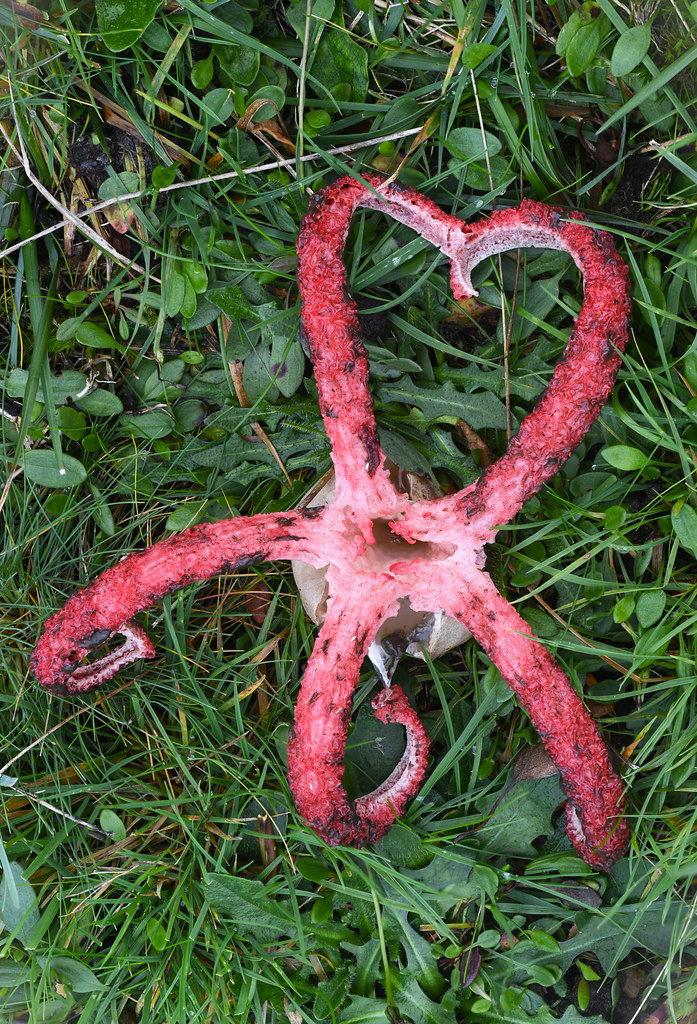#non-native wildlife
Video
Love is...An Alien Fungus that smells of Corpses... by Will Atkins
Via Flickr:
This Devil's Fingers Fungus (Clathrus archeri) seems to be trying to communicate a message of peace and love...
#Devil's Fingers#Devil's Fingers Fungus#Clathrus#Clathrus archeri#Heart#Love#Fungus#Fungi#European Fungi#British Fungi#UK Fungi#Hampshire Fungi#New Forest Fungi#New Forest#New Forest wildlife#Fungi of Britain#Fungi of the UK#Fungi of Hampshire#Fungi of Europe#Fungi of the New Forest#Heathland#Mushroom#Toadstool#Toadstools#Alien Species#alien wildlife#Non-native species#non-native wildlife#Nikon#Nature
38 notes
·
View notes
Text
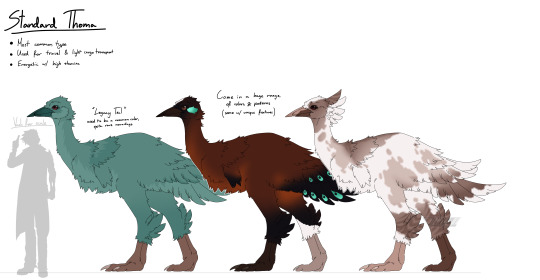
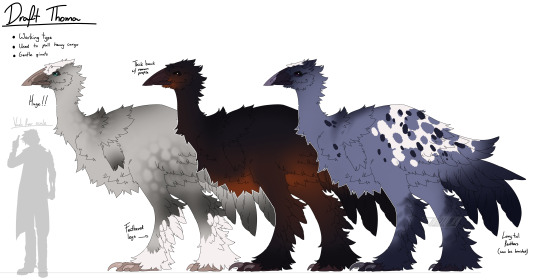

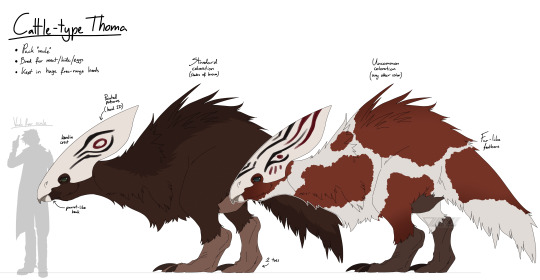
cowboy au worldbuilding with the thoma
as you can see im taking some creative liberties with the giant emu by making them more diverse bc canon isnt enough for me and i have the brainworms
extra notes below the cut
standard thoma:
the original thoma and most common type available
perfect for travel, can pull wagons or carry light cargo
fast with good stamina, fastest over short distances
friendly, intelligent, energetic and quick to learn
the most diverse in terms of colors, patterns and extra traits
well rounded in all departments (theyre like the AQ horses of trigun)
draft thoma:
uncommon outside of major cities (kept by specialized breeders)
used for construction work and long haul heavy cargo transport
gentle, patient and eager to work
not built for speed but can walk for days at a steady pace without rest
dense feather coat protects them from the heat and sand
expensive to maintain and keep due to their size
theyre a relatively new type that came from selective breeding
"wild" thoma:
actually feral (aka. previously domesticated), not wild
originating from lost/runaways that have not been in contact with humans for generations
rare and elusive with a small population, sometimes spotted living near shipwrecks
people will pay top $$ for their capture
begin to exhibit adaptive mutations that help them survive the wastelands
smaller and less fluffy than their standard counterparts
dont come in many colors, mostly bays, chestnuts and blacks
hardy with incredible endurance
very stubborn, temperamental and intelligent, cant be forced to do something they dont want (like donkeys)
rarely ridden, mostly kept for crossbreeding
cattle-type thoma:
related to the standard thoma but NOT the same species
common pack animal in caravans, sometimes ridden as a cheaper alternative to the standard thoma
mainly bred for meat, hide and eggs
kept in huge open range herds that travel along worm swarms for feeding
sometimes kept as a form for anti-worm pest control
keratin crests are lightweight and used for protection and display
ranchers will paint patterns on their crests as a form of identification
not the sharpest tools in the shed, tend to bite and trample people
#trigun#trigun stampede#cowboy au#worldbuilding#andr0art#i like speculative biology idk what to tell you#its the brainworms#sorry for the horrible handwriting btw#also ik that significant adaptive mutations take longer to appear than a 100 years#but lets say they adapt fast due to genetic modification#the implications of what seeds did after the fall to adapt to the wastelands fascinates me#since thoma arent native to no mans land iirc#did they just have them on board?#what ab other animals?#what kind of non-native wildlife is there#i know there are birds and like... a cat#<- still hasnt read trimax#everything i know has been obtained via tristamp and osmosis#also yes im bringing in the og thoma#diversity win!#i needed a substitute for cows so vash and wolfwood have something to herd for cash#living the cowboy dream baby!
500 notes
·
View notes
Note
Introducing bison to Britain is honestly such a stupid idea. To start with, if you look it up European bison have never been native to the uk, they’re just related to the forest bison which WAS native, but also went extinct in the Pleistocene, some 12,000 years ago. I don’t feel like you can call introducing a species which is related to a different species that went extinct when there were hippos and lions in Britain reintroduction. And there really aren’t that many places for them to go either. Nature reserves and forests big enough to support a population of bison generally already have an established population of wild ponies that they’d compete with, and a lot of the time farmers have grazing rights for their sheep and cattle on common land as well. Plus there’d be no way for the bison to travel between them so there’d be no population mixing. The current “rewilding” project is basically just 3 European bison in a private zoo in some Kent woods, and it’s really difficult to see how it could ever be more than that.
Ah, I see. I hadn’t realized the bison in the UK were not only a different species from wisents altogether but also not found there since the Pleistocene.
So would you perhaps say that, pardon, the UK wants to release random [Eastern European] animals into their ecosystem?
#/lh#but this revelation is quite literally the funniest possible twist in this saga#I was slightly off but in general terms I was also RIGHT because they are releasing non-native wildlife there#This entire ride has been incredibly funny from beginning to end#at least the beavers are native to the UK lol#I hope the slow worm project goes well at least#and I wish the lynx and wolf project had a snowballs chance in hell#I don’t remember bullet point three but best of luck to that too
2K notes
·
View notes
Text
Apparently, redwoods love our damp climate. Our back neighbours used to have one, but they cut it down. Not so suitable for suburban gardens...
Can any arborists weigh in on this and any effects they might have long term on the ecosystem? Unlike in California, our sequoia are spread out all over the country. It's very unlikely that these trees will be exposed to forest fires (actually maybe not with climate change doing what it does)
10 notes
·
View notes
Text
I miss my baby 😭
#grief#mourning#loss of a child#loss of a loved one#organ donor#organ donation#gift of hope#save the bees#pollinators#environment#native plants#save the pollinators#nature#trees#plant trees for the future#autism#nonbinary#awn#autistic women and non-binary network#certified wildlife habitat
2 notes
·
View notes
Text
In November, the U.S. Fish and Wildlife Service (USFWS) published a plan to cull nearly half a million barred owls across the lush old-growth forests of the Pacific Northwest and California.
But by killing these owls, the agency is hoping to save owls—albeit a different species of the bird. Officials plan to remove a portion of the abundant barred owl population over a three-decade span to clear up space and resources for the threatened northern spotted owl, of which only around 4,000 remain on federal lands. Native to the region, spotted owls have faced a number of threats in the past few decades, including forest loss due to logging and competition with the barred owl, which has been more successful at hunting and adapting to a variety of territories than its vulnerable avian cousin.
Scientists are still not certain how or where the barred owls came from, but research shows that they began to expand their range westward concurrently with European settlement and as human-caused changes altered habitats in the Great Plains and northern boreal forest. As a result, many say the barred owls are an invasive species and must be removed to protect native species, reports NPR.
However, the USFWS culling plan has triggered a spate of backlash since it was announced; just last week dozens of wildlife organizations published a letter condemning this effort and arguing that it “betrays a willful failure to anticipate the wide range of adverse consequences such a plan will invariably unspool.”
The plan has also resurfaced a longstanding debate over what makes a species “invasive,” and how nonnative plants and animals should be treated within an ecosystem. Today, I am diving into the details of the invasive debate, and how it could affect wildlife management moving forward.
What’s in a Name? The author Charles Elton was the first to use the term “invasion” to describe foreign plants and wildlife in his 1958 book “The Ecology of Invasions by Animals and Plants,” reports The New York Times.
Scientists have identified countless nonnative invasive species across the U.S.—from cane toads in Florida to fingernail-sized zebra mussels in the Great Lakes. In most cases, these species are introduced by humans who may accidentally carry them over on transit or intentionally release them. While many nonnative species are relatively harmless to an ecosystem, others can have catastrophic consequences; for example, feral pigs have destroyed crops and spread disease across at least 35 states in the U.S., according to the USDA.
...
“The words we use determine what courses of action are deemed acceptable and appropriate,” Bliss told me over email. “When we call something invasive, we may show less regard for their welfare.”
Bliss pointed to certain inhumane methods to kill nonnative species such as traps once used in the Netherlands to kill muskrats by holding them underwater until they drown. Other researchers have also questioned the term “invasive.”
“It’s not that it can’t be descriptively true at times, there can be nonnative species moving into an area, causing damage, which is emblematic of the meaning of invasion,” William Lynn, a researcher at Clark University in Massachusetts who studies animal and sustainability ethics, told me over the phone. “But to label species ‘invasive’ simply because they’re nonnative or they’re immigrant species, or to blindly bandy about the term ‘invasive’ species when it’s not clear that that’s what’s going on, is the problem.”
The Owl Conundrum: The northern spotted owl is listed as threatened under the Endangered Species Act, meaning that the USFWS is legally required to protect it. This led the government to enact rules limiting the area that timber companies could log, sparking backlash from industry and residents in the region for its economic impacts.
Now, the Service has deemed this cull a necessity in following through with this obligation.
...
The U.S. government has performed a barred owl culling experiment before, but at a much smaller scale than the new USFWS project. Over a decade ago, a team of researchers led by the U.S. Geological Survey killed more than 2,400 barred owls, and found that their efforts helped temporarily stabilize spotted owl populations over the next five years, according to a 2021 study.
At that time, Lynn was a member of the government’s “Barred Owl Stakeholder Group,” which performed an ethics review before the project took place.
Despite the groups’ “deep discomfort with killing barred owls,” they deemed it necessary to cull several thousand barred owls in order to save the spotted owl species, Lynn said. Overall, though, he said that the experiment “failed” because while it slowed the decline of the spotted owl, it did not act as a long-term solution.
“It’s a very different situation now,” said Lynn, adding that he does not think this new cull will save the spotted owl.
#enviromentalism#ecology#us fish and wildlife service#wildlife services#BS Culling#owls#pacific northwest#california#barred owl#spotted owl#endangered species#Non-native species#Turns out killing you way out of a problem doesn't really work
0 notes
Text
The fun thing about being a wildlife biologist is people ignorantly and cheerfully confessing things they’ve done with wildlife that, if not outright illegal, at the very least is extremely frowned upon
#like yeah you shouldn’t have taken that box turtle home that’s… illegal and causes more issues than it should#and yes that non-native lizard species is already well established in this area#bUT JESUS CHRIST DONT HELP IT SPREAD EVEN MORE??? BY BRINGING IT TO YOUR NEW NEIGHBORHOOD????#oh you’re gonna stand there and tell me how you kill rattlesnakes while I stand here giving a presentation on them😀 okay#no I can’t take that raccoon your neighbors trapped as a pet that’s… no…. that’s not legal#by yours truly the omelette of cheese#wildlife biology
4 notes
·
View notes
Text
If you aren't following the news here in the Pacific Northwest, this is a very, very big deal. Our native salmon numbers have been plummeting over the past century and change. First it was due to overfishing by commercial canneries, then the dams went in and slowed the rivers down and blocked the salmons' migratory paths. More recently climate change is warming the water even more than the slower river flows have, and salmon can easily die of overheating in temperatures we would consider comfortable.
Removing the dams will allow the Klamath River and its tributaries to return to their natural states, making them more hospitable to salmon and other native wildlife (the reservoirs created by the dams were full of non-native fish stocked there over the years.) Not only will this help the salmon thrive, but it makes the entire ecosystem in the region more resilient. The nutrients that salmon bring back from their years in the ocean, stored within their flesh and bones, works its way through the surrounding forest and can be traced in plants several miles from the river.
This is also a victory for the Yurok, Karuk, and other indigenous people who have relied on the Klamath for many generations. The salmon aren't just a crucial source of food, but also deeply ingrained in indigenous cultures. It's a small step toward righting one of the many wrongs that indigenous people in the Americas have suffered for centuries.
#salmon#dam removal#fish#animals#wildlife#dams#Klamath River#Klamath dams#restoration ecology#indigenous rights#Yurok Tribe#Karuk Tribe#nature#ecology#environment#conservation#PNW#Pacific Northwest
14K notes
·
View notes
Text
One thing I've unfortunately learned from gardening, hiking and wildlife ID groups on Facebook is that the average person has no idea that "invasive" specifically means when something non-native is ecologically harmful. A whole whole lot of people think it literally just means a "pest" in any context at all, so I catch people in the USA describing our own hornworms, poison oak, even raccoons as "invasive." They just hear news stories about "invasive wildlife" and that it's damaging something and all they think is "oh, this term means when an animal or plant inconveniences me and is hard to get rid of."
I can fully see how that mental connection works and it's really not all their fault. The word does not on its own really tell you how it's meant to be used. That, and a lot of people just don't understand the difference between what matters for the ecosystem and what digs up their store bought unnatural flower cultivars.
4K notes
·
View notes
Text
I always say this but non chileans fans of Pedro really dont give a fuck when he posts or shares chilean related things like right now we have MASSIVE wildfires going on. 100+ people lost their lives in Viña, Quilpué and more and that list is only going to grow because there is so much devastation that we have no enough resources to retrieve the corpses. This is the most deadly dissaster in our country since the 2010 earthquake in Constitución.
Lots of people lost their homes, loved ones, sources of income. In Viña we had a 100+ years old massive garden, home to lot of native species of flora and wildlife and it was totally destroyed by the fire.
And i guess this hits specially for Pedro since almost everytime he comes to Chile, he stays in Cachagua which as Viña is located in Región de Valparaíso.
We need all the help possible and if you care about the man, at least you can donate or share the links he posted.
You can donate here: Desafío levantemos Chile
#Pedro Pascal#i follow lots of pedro fan accounts on tw and only one is sharing this#but oohhh when he shares things about the us yall run to give that attention BUT ONE POST ABOUT CHILE AND SUDDENLY YOURE BLIND#im so mad#chile#escribí como el hoyo pero estoy 😤
791 notes
·
View notes
Text

Flora & Fauna 🇵🇸
this is the first of what I'm hoping will be several peices on my inprnt shop that will exist for the explicit purpose of perpetually supporting Palestine
all profit I receive from it's sale will go directly to Care For Gaza, the purchase of E-sims or other credible organizations/grassroot efforts in the area
every animal and plant featured in this peice is native to Palestine, just like the Palestinians who exist there today
to learn more about Palestinian wildlife, I recommend checking out this organizations archive documenting the country's natural beauty: https://www.mahmiyat.ps/en/flora-and-fauna
to learn more about ways to support Palestine, click the Read More
to buy the print click here
history and information:
the official BDS boycott list:

grassroots aid efforts and non-profit charities:
836 notes
·
View notes
Text
everyone should try to get into bugs because they fulfill all your primal needs to get Way Too Close to wildlife and hold and pet wild creatures
When you start recognizing bugs as friendly and cute little Guys, your world opens up so much.
They're easy to obtain. Do you want isopods? Just put a piece of cardboard on the ground and you will have isopods. There's a straight-up CLOUD of bees, wasps, butterflies, and flies around my Swamp Milkweed. Planting any native flower will make you so many friends. Better yet, do nothing—any somewhat overgrown area is habitat. I was hacking down some of the grasses in the Weed Area in our back yard yesterday (the non-native chicory is overpopulated and the native perennials are getting swallowed up by a Crap Ton of non-native grass) and found a enormous katydid.
I am feeling such awe and wonder over how tame and unbothered insects are in front of humans. Lots of them you can catch and hold in your hands and they will just be like oop oh well this is strange sorry to bother you and fly away.
They are so beautiful too! The COLORS. Electric blue! Iridescent green! Bright red! Every metallic shade! Rainbow! Our yard is full of dragonflies now and they've got to be one of the world's most elegant creatures.
11K notes
·
View notes
Text
Humans really like space wildlife
As Humanity integrates itself within the Galactic Coalition ever further, trade and travel between Sol and neighboring member systems is growing at exponential rates. In particular, their interest in the native wildlife of other planets is the most widely expanding sector for tourism and commerce.
Even though it is also the most heavily regulated and restricted one, Humans, who typically display a desire to subvert the normal procedures to expedite any process they can, for this they are surprisingly willing and eager to fill in all the necessary paperwork and spend hours upon days making sure they follow and adhere to all the requirements to import some of these creatures.
While such level of determination is not uncommon for new member species who discover a certain non-native creature or something that to the respective natives is commonplace but for them is the pinnacle of exotic, the variety of requests made by Humans is nearly as great as the entire list of known fauna species. And the reasons listed on the forms are even more diverse:
"That's a unicorn! I've always dreamed of having a unicorn and you're telling me there's a dozen subspecies?! Yes, please!!!"
"After reviewing their behavior, this bear-sized fluff-ball is the perfect cat I've always wanted, but couldn't because of allergies. I'll treat them with love and care, my life is incomplete without this fella."
"Tiny. Elephant-duck. Want."
"Our company was looking for a mascot, and these six-legged spindly beaver-crabs are perfect. Here's our mission statement and prepared accommodations for a flock."
"They all said I hallucinated the lizard sasquatch when I was on that acid trip, but now I'll show 'em. It's real. I knew it all along!"
"Aww, these baby puppies are so adorable (referring to the four meter, 800kg Fanged Widowmaker of Abyss Valley predator). My kids were looking through your alien picture books and instantly fell in love with these ones."
And so on. At first we had to reject quite a few, mainly because half of them were deadly beasts from Deathworlds that are almost impossible to capture in the first place. Then the Human officials informed us that, while they will try to stop it from happening, if we don't make importing and adopting even the most dangerous animals in the known Galaxy reasonably possible for them with Human help and expertise in the field, some Humans will set up illegal smuggling rings to "fill the market gap" as they said. Historically, they explained, that causes more problems and expenses than just handling it through official channels.
Reluctantly we were persuaded and have set up a new organization to quell this, apparently, unquenchable Human pack bonding condition. Even if said pet can kill them. We think, as horrible as it may be, that for some that is part of the appeal. Even the ones that breathe out literal poison.
"We'll wear a mask around them. This wendigo-like one is too cute to not get belly rubs."
Said the OFFICIAL Human Representative of a monstrosity that can only be described as the living incarnation of countless teeth, fangs, claws, vivid seizure inducing iridescent feathers, and a body that extends from a inconspicuous ambush pose to a fully 8 meter tall six limbed nightmare machine of Death!
#humans are space orcs#humanity fuck yeah#humans are deathworlders#humans are space australians#humans are space oddities#carionto#aliens are cute#pet the predator
1K notes
·
View notes
Text
Plant native plants
What's up, northern hemisphere homies? Spring is coming and soon, many of you may be looking toward gardening. When you're deciding what to plant, I have two words for you to consider:
Native. Wildflowers.
There are huge benefits to planting native plants over store-bought plants.
Native plants are already adapted to the local soil. Lots of ornamental plants (especially lawn grass) pull nutrients out of the soil without giving anything back. Native plants are much better at supporting the nutrient cycle.
They are low-maintenance. Because native plants are already adapted to your local conditions, they need much less care and maintenance. You can save time and money on fertilizers, pesticides, herbicides, and water.
Native plants support the local ecosystem. The plants have evolved alongside with animals, meaning they feed local insects, birds, and other animals. They also provide shelter for wildlife, attract pollinators, and boost the local animal populations.
They increase biodiversity. In my country, huge swaths of native land have been bulldozed and replaced with ecologically damaging farmland, lawns, and non-native ornamental plants. By planting natives you help restore the ecological balance and can get an idea of what the land used to look like. Planting natives on your property can spread the seeds to other locations through wind or animal dispersal.
They are sustainable. You can harvest seeds off of your natives and grow your garden, give them to other people, or scatter them in the wild.
They are diverse and unique. How many gardens are full of the same old standards like peonies, daffodils, and tulips? Native plants often look much more unique and interesting than the same old ornamentals. Here are some local species from my area that I think are much better looking than a lot of ornamental cultivars. (top to bottom: prairie blazing star, showy tick trefoil, Virginia bluebell, dutchman's britches, bottle gentian).



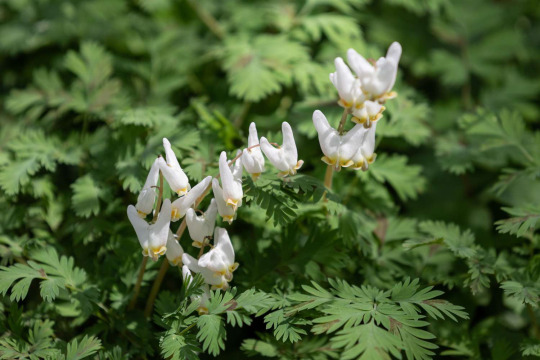
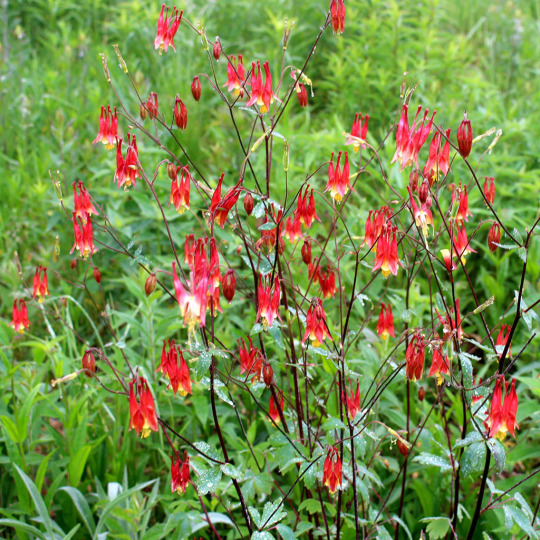

Do some research about which species are local to your area and see if your local garden stores have any native species. A lot of places will have naturalist groups who will sell native plants or their seeds or can point you to places you can get them. You may be able to harvest seeds directly off the plant if there are natural areas near you. However if you are harvesting natural plants, check local laws and see who owns the property. The general rule of thumb is that for abundant native species, you can safely harvest about half of the seeds without impacting the regrowth next year. For rarer species, you shouldn't take more than a quarter. If a lot of people are harvesting in the same area, they may be taking too much.
157 notes
·
View notes
Note
is it true that in america picking up bird feathers is illegal? im curious because there's no way to check if you've picked up a rogue feather, is there? we pick up feathers left and right here and i always wonder why such a law even exists! it's not like the birds need the feathers that fell out, right?
Yes and no. The MBTA (Migratory Bird Treaty Act) was put in place after extreme overhunting of birds for feathers to use in decorative hats, clothing, etc (often without even using the corpse itself) led to a huge decline in bird populations (it’s also credited as a large part of the Carolina Parakeet’s extinction). The law does technically make it illegal to keep bird feathers of native species. However, the likelihood of, for example, a kid picking up a bluejay feather and taking it home, then getting arrested, is nonexistent. The law is mostly there to prevent sales of these items, because it’s easy enough for a merchant to claim to have ‘found’ or naturally obtained molted feathers, when killing and plucking a bird is a much easier way to gain feathers. I picked up native bird feathers all the time as a kid, and it never led to legal issues.
I see both sides of things - I love birds and am passionate about conservation, but I’m also interested in vulture culture / collecting from nature. While it’s a bummer that I can’t keep all the cool feathers I find, I think overall the law is beneficial to wildlife, so at the end of the day I’m at peace with it.
You can also legally keep non-native species, for example European Starlings, pigeons, etc, along with the feathers of any domestic/pet bird.
384 notes
·
View notes
Text
Ok, new garden idea!
I remain desperate to remove the ugly low non-native pine hedge at the alley side of the yard. I never see any wildlife around it and it does nothing to obscure the view of garages and trash bins.
Eventually the apple and plum trees will obscure the upper part of the view, so I wanted something to obscure the lower part of the view.
My latest concept: the thorn beds!
The ground along that side is thick with big woody roots, so cutting them down and plopping a raised bed on top makes sense. the roots will break down eventually and make nice rich soil, but it's hella hard to plant into.
And, Ty misses our old garden's raspberry bed. I keep raspberries in beds because, as anyone whose grown them knows, they like to escape and run rampant.
But from an aesthetic viewpoint they're just sort of....a big green blob of a plant.
But how cute would it be to do a mixed bed of raspberries and raspberry colored roses? These plants like similar conditions and the roses are good at not being strangled by the berries.
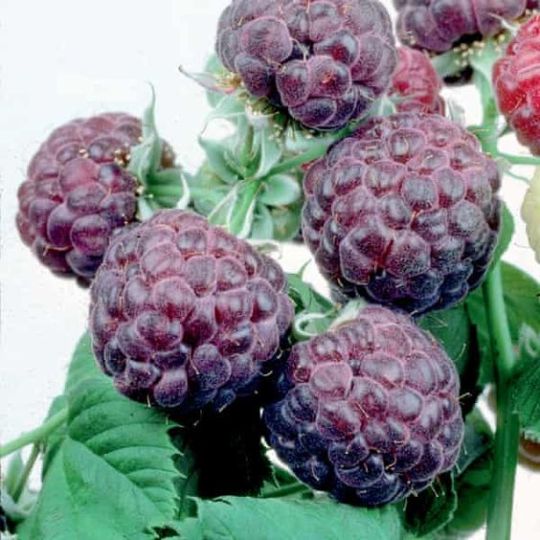
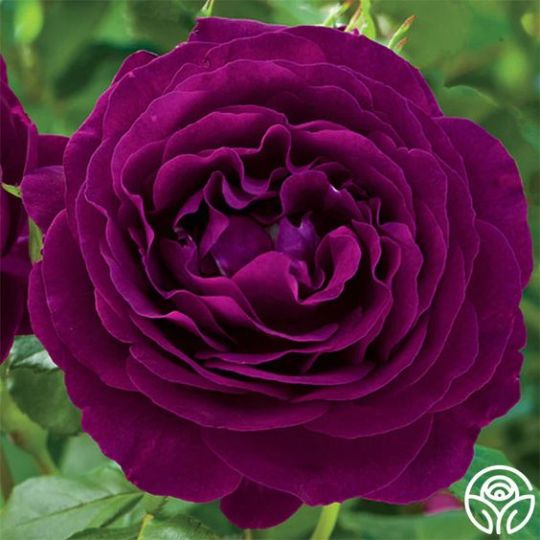

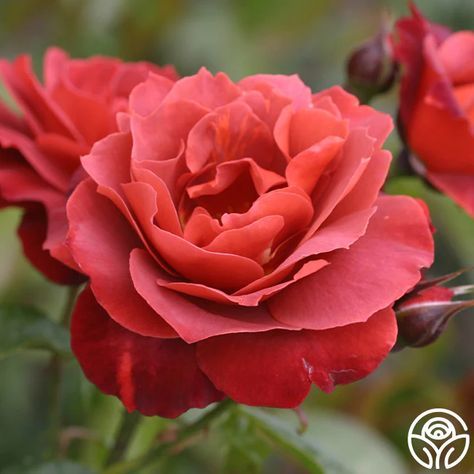
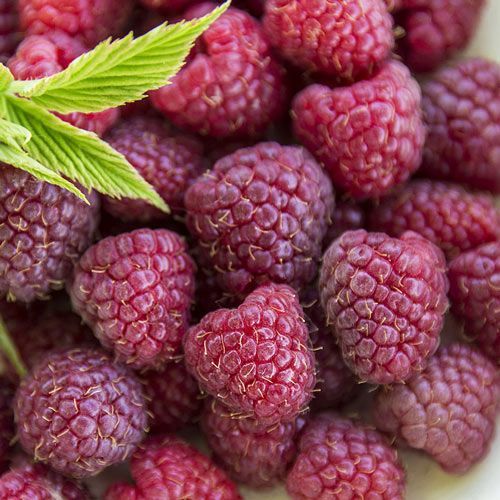


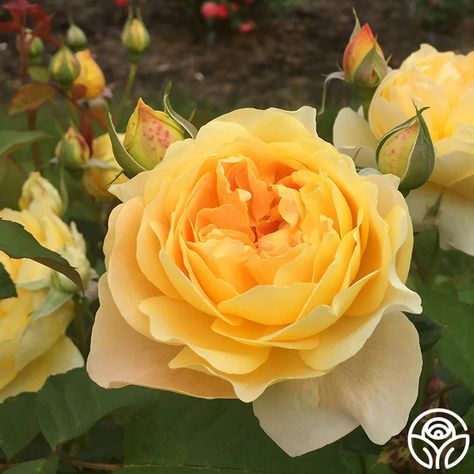
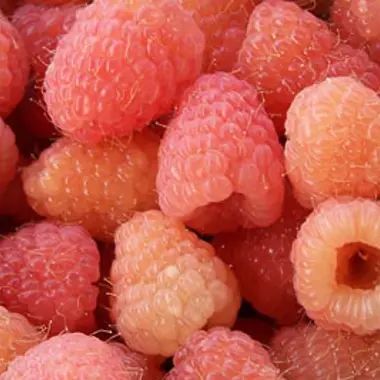



So yeah. Kind of obsessed with this idea.
#organic gardening#urban gardening#gardening#gardenblr#edible gardening#roses#raspberries#rhombus house garden
174 notes
·
View notes
